••• employee research
Overworked but enjoying the job
Managers willing to take pay cut for lighter workload
 Managers have a large effect on employee productivity and engagement, as well as other factors that create a great place to work like building trust, fostering open communication and caring for employees as individuals, according to a study by the UKG Workforce Institute. However, managers also report the highest levels of burnout at work, underlining the critical need for more organizational support to be the most effective in their roles.
Managers have a large effect on employee productivity and engagement, as well as other factors that create a great place to work like building trust, fostering open communication and caring for employees as individuals, according to a study by the UKG Workforce Institute. However, managers also report the highest levels of burnout at work, underlining the critical need for more organizational support to be the most effective in their roles.
Seventy-three percent of employees say their manager’s support, encouragement and/or leadership directly motivates them to go above and beyond in the workplace and more than a third (37%) say having a good manager – one who’s accessible but doesn’t micromanage – makes them feel the most productive at work. Eighty-seven percent believe their manager trusts them, 79% say their manager supports their career goals, 75% feel their manager cares and has empathy for them and 63% believe their manager supports them as a whole person.
When it comes to open communication, a pillar of building a great place to work for all people, 59% of employees say their manager is approachable and easy to talk to. Most employees also have regular conversations with their managers that motivate them. Nineteen percent of employees say these conversations occur daily and 35% say the constructive chats happen weekly.
Managers are feeling a great crunch from the role’s responsibilities. Eighty-six percent report experiencing job burnout (i.e., work-related stress associated with physical and emotional exhaustion) – the most of any group, including employees (82%) and even C-suite leaders (73%). So much so, that nearly half (49%) of all managers surveyed say they would accept a pay cut to reduce their workload.
Those who feel supported by their managers feel more engaged in the workplace. Ninety-three percent of employees who say their manager trusts them also feel “energized.” They genuinely enjoy work, are passionate about their career, care about their company, co-workers and/or customers and are inspired to always go above and beyond without being asked. Eighty-four percent of employees who say their manager supports their career goals also feel “committed.” They like their work and care about their career, they often put in additional effort to make sure they do a good job for their company, support their team and/or serve their customers and they’re happy to go above and beyond at work when needed.
It’s no secret that being a leader is one of the most challenging roles in the workplace today. Despite the dynamic demands, 79% of managers still say they enjoy being a manager and hope to always remain in a management role. Sixty percent of managers chose the role because they “like to help others succeed.” Others point to a higher compensation (54%), career progression (36%) and having power (24%).
Most also recognize that their role expands beyond just managing their teams and often means serving as a coach both inside and outside of the workplace. Eighty-eight percent of managers say they regularly mentor employees and help them advance in their careers and 86% believe they can talk to any of their direct reports or peers about work or personal issues.
Walr conducted this survey from August 16-September 4, 2023, with 4,200 employees in nine countries. In the U.S., the study also included managers and C-suite leaders. Responses were gathered from 1,800 total workers in the U.S. (600 employees, 600 managers and 600 C-suite leaders), 1,000 employees in Australia/New Zealand and 200 employees each in Canada, France, Germany, India, Mexico, the Netherlands and the U.K.
••• shopper research
Too many happy returns?
Online shoppers admit to questionable behavior
 Nearly four-in-10 U.S.-based online shoppers (39%) admit to having either engaged in return policy abuse or fraudulent behaviors in the past 12 months, or know of someone who has, found Loop, a return-management platform for e-commerce brands. The behaviors respondents were asked about spanned outright fraud, return policy abuse and other unfavorable return behaviors.
Nearly four-in-10 U.S.-based online shoppers (39%) admit to having either engaged in return policy abuse or fraudulent behaviors in the past 12 months, or know of someone who has, found Loop, a return-management platform for e-commerce brands. The behaviors respondents were asked about spanned outright fraud, return policy abuse and other unfavorable return behaviors.
Alarmingly, between 20% and 30% of shoppers who admit to engaging in these behaviors do so at a high frequency. Thirty-one percent of these respondents said they have worn or used an item while planning to return it at least once a week. Over half of shoppers (54%) agree they commonly engage in “bracketing” – ordering multiple items to determine size/fit, with the intention of returning at least one item. Nearly a third (31%) said they needed the money they’d spent on an item back. However, a significant number of respondents had less benign intentions, stating they wanted an item for a single event (36%), they were taking advantage of a lenient return policy (23%) or wanted to keep an item without paying for it (15%).
Fifty-one percent of respondents say it is common for them to order multiple items with the intention to return some or all to determine their size or fit preference. Most respondents (72%) say they will choose to purchase from a company that lets them wear/use the items with the ability to return them over a competitor that doesn’t. Nearly all respondents (96%) agree that flexible returns show that a company cares for its customers.
Return policy abuse, fraud and other unfavorable return-related behaviors can exploit the return process, yet some of these behaviors are common and are not always considered by consumers or merchants to be abusive. These behaviors range from minor policy violations to unfavorable behaviors that impact merchants financially to outright illegal activity. The National Retail Federation estimates that 13.7% of returns in the U.S. in 2023 were fraudulent.
Loop surveyed 1,000 U.S.-based consumers who made a return in the last 12 months for an online purchase between November 22 and December 3, 2023.
••• political research
Voters anticipate AI interference in election
Democrats, Republicans feel cybersecurity anxiety
 To better understand how voters perceive cybersecurity ahead of the 2024 U.S. election, hardware authentication security keys provider Yubico and Defending Digital Campaigns, a nonprofit offering free cybersecurity tools and resources to federal election campaigns, surveyed registered voters to determine the effects of artificial intelligence and the cybersecurity concerns voters have regarding political campaigns, regardless of party affiliations.
To better understand how voters perceive cybersecurity ahead of the 2024 U.S. election, hardware authentication security keys provider Yubico and Defending Digital Campaigns, a nonprofit offering free cybersecurity tools and resources to federal election campaigns, surveyed registered voters to determine the effects of artificial intelligence and the cybersecurity concerns voters have regarding political campaigns, regardless of party affiliations.
In addition to the threat of AI and deepfakes spreading misinformation, 85% of respondents aren’t confident that political campaigns effectively protect their personal information. There is bipartisan agreement with 79% of Democrats and 80% of Republicans showing concerns over AI-generated content being used to impersonate a political candidate or to create inauthentic content.
Forty-two percent of those who have donated to a campaign say their likelihood of donating again would change if the campaign was hacked and 30% report that it would even change the likelihood of a candidate receiving their vote. Over a quarter of respondents (26%) say that when donating to a campaign online, they have not completed the transaction because they were concerned about the security of the transaction and how their personal information would be handled. Forty-three percent of respondents believe that AI-generated content will negatively affect the outcome of the 2024 elections.
From a data security perspective, 85% of respondents don’t have a high level of confidence that political campaigns effectively protect the personal information they collect. Fifty-two percent of respondents have received an e-mail and/or text message appearing to be from a campaign that they suspected was actually a phishing attempt.
Registered voters would like to see campaigns and candidates take precautions to prevent their websites from being hacked (42%), use strong security measures like multifactor authentication on their accounts (41%) and have policies in place and train staffers and key volunteers on cybersecurity for the campaign and protecting personal information (38%).
The survey was conducted by OnePoll with 2,000 registered voters in the U.S.
••• health and wellness research
Foods with benefits
Americans crave wellness products
 More than half of Americans (55%) say they're more likely to try a new product if it's marketed as being aligned with a healthier and more sustainable lifestyle, according to advertising effectiveness company NCSolutions.
More than half of Americans (55%) say they're more likely to try a new product if it's marketed as being aligned with a healthier and more sustainable lifestyle, according to advertising effectiveness company NCSolutions.
Over half of American consumers (59%) recently purchased a new product because of its health benefits. Nearly half (47%) say they've specifically purchased a food or beverage product in the last 30 days to get more vitamins or nutrients, to improve sleep (33%) and to support gut health (29%). Twenty-seven percent of Americans purchased a new product because it is good for the environment.
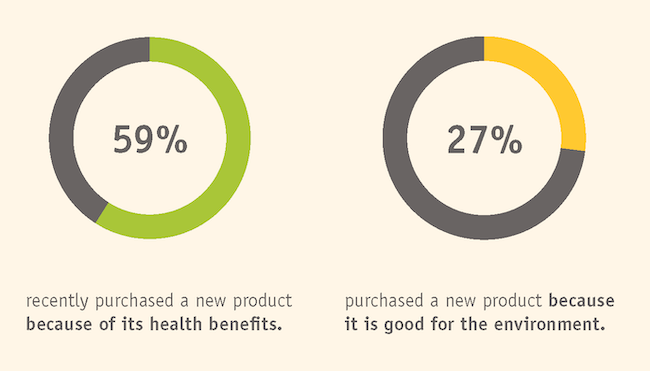
Younger generations are more likely to consider the effect of their food or beverage product choices on the environment than older generations. Forty-eight percent of Gen Z and 44% of Millennials consider this effect always or often, compared to 33% of Gen X and 29% of Baby Boomers. Likewise, younger consumers factor in the effect on the environment of their choice of laundry or cleaning products more often than older consumers. Fifty-one percent of Gen Z and 41% of Millennials consider this effect always or often, compared to 33% of Gen X and 35% of Baby Boomers.
Almost half (47%) of consumers say that when they see a brand advertising products they typically buy, they're more likely to keep that brand in mind the next time they shop. Additionally, if a brand's mission aligns with the consumer's values, 58% say they're very or completely likely to buy that brand's product. When a CPG brand's healthy and sustainable marketing message syncs with a consumer's values and preferences, 42% say it enhances their overall positive brand perception. However, controversial stands from a brand can also backfire as 28% of Americans prefer to keep controversies out of the shopping cart, while 19% only like it when the brand agrees with their own opinions.
Health- and eco-conscious consumers are most influenced to buy a wellness or sustainable product after seeing it advertised on TV and ad-supported streaming (44%) followed by social media (39%) and internet/website display ads (37%).
Celebrity and social media influencers can also hold sway over a consumer’s decisions. However, the impact of endorsements is split – 55% of consumers are at least somewhat likely to try a product that improves well-being or the environment when there is a celebrity or social media influencer involved. In comparison, almost a quarter of Americans (24%) are not influenced by a celebrity or social media influencer who endorses a healthier or environmentally conscious product. Consumers are most likely to purchase products that support a healthier self or healthier earth at the grocery store (67%), on a website (39%) or in a drug store (39%).
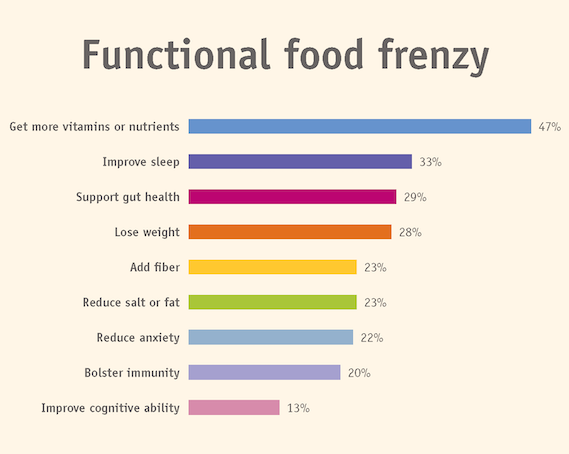
NCSolutions commissioned this survey of 1,104 Americans in February 2024.
••• small business research
Keeping an eye on AI
Business owners waiting to adopt new tech
 While only 39% of small businesses are currently using AI, that percentage is expected to jump to 51% by the end of 2025. There is good reason for the anticipated uptick. In quantifying the benefits of AI tools, small business software platform Thryv found that more than half of responding AI users expect to save between $500-$2,000 and up to 20 hours per month.
While only 39% of small businesses are currently using AI, that percentage is expected to jump to 51% by the end of 2025. There is good reason for the anticipated uptick. In quantifying the benefits of AI tools, small business software platform Thryv found that more than half of responding AI users expect to save between $500-$2,000 and up to 20 hours per month.
With the time saved using AI, small business owners would use the extra hours to improve current processes (52%), attract new customers (46%), develop ideas to expand the business (46%), develop marketing or other content (45%) and spend the extra time with customers (31%) and employees (21%). With the money saved, small business owners would add products, inventory or additional services (52%), increase their marketing and advertising (51%), add more technology or software (41%), improve or add business locations, vehicles or equipment (29%), pay down debt (28%) and hire more employees (26%).
Small business owners appreciate how AI can impact how they operate and 73% say it will offload repetitive tasks, 67% believe it will give them some personal time back, 58% say it will help with resource constraints and 37% think AI will make them less reliant on employees.
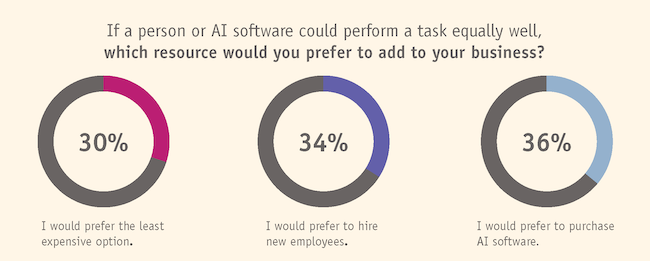
When asked if they needed to add a new resource to their business, and either a person or AI software could perform the task equally well, small business owners were evenly divided with 36% preferring to purchase AI software, 34% preferring to hire a new employee and 30% saying they would choose the least expensive option. AI usage increases along with the size of the business. Forty-seven percent of businesses with 10+ employees use AI, 40% of businesses with five to nine employees use AI and 27% of businesses with one to four employees use AI.
Age matters when it comes to AI adoption. Less than a third of small business owners aged 60+ are using AI and almost half in this age group do not plan to use AI for their business. Forty-three percent of small business owners using AI are in the 21-49 age range. Forty-two percent of 21-49-year-olds, 39% of 50-59-year-olds and 33% of those 60+ are not sure whether they will incorporation AI in the future.
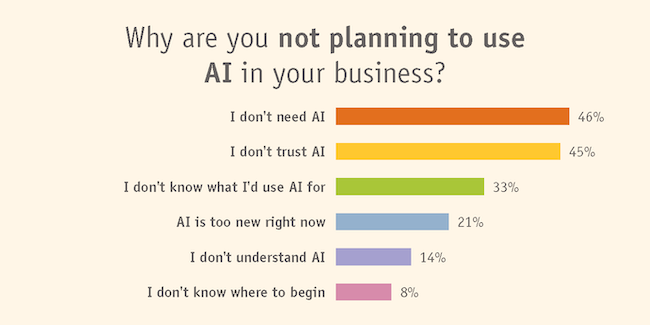
Thirty-three percent of respondents feel they are becoming less competitive the longer they wait to adopt AI but 63% say they want to see how AI effects other small businesses before making the final decision. Forty-six percent say they don’t need AI, 45% don’t trust AI, 33% are not sure what they would use it for, 21% say AI is too new, 14% don’t understand it and 8% are unsure where to begin.
Thryv conducted the survey of 500+ small business owners in April 2024.
••• real estate research
A unique path to home ownership
Prospective buyers weigh options
 From purchasing multifamily properties to co-owning with friends and family, prospective buyers are willing to get creative to become homeowners in the next 12 months, reveals real estate company RE/MAX.
From purchasing multifamily properties to co-owning with friends and family, prospective buyers are willing to get creative to become homeowners in the next 12 months, reveals real estate company RE/MAX.
With fluctuating market conditions and the uncertain rate environment, nearly 80% of prospective homebuyers are considering adjusting their purchasing plans. Forty-three percent of respondents have considered other property types (fixer-upper, foreclosure or tiny home) and financing options. Fifty-six percent say they would consider purchasing a fixer-upper in need of remodeling, either for cosmetic or structural reasons. Thirty-four percent of respondents would consider purchasing with a down payment of less than 20% and more than nine in 10 respondents were somewhat or very likely to discuss their alternative options with a real estate agent.
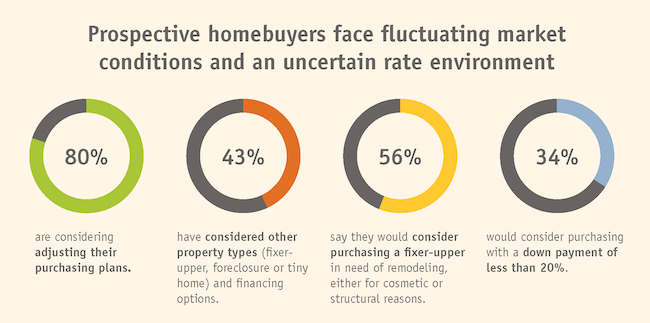
Affordability remains top-of-mind for homebuyers. Seventy-three percent of those who indicated they would consider purchasing a fixer-upper wanted the chance to purchase a home at a lower listing price. More than a quarter of consumers indicated they would consider purchasing a multifamily home, defined as a property occupied by the owner and additional non-owner tenants, and half of them would do so to split the cost of monthly mortgage payments.
Thirteen percent of prospective homebuyers reported they'd be willing to consider a long commute, buying a home over two hours away from where they work, for more affordability. Of the 34% of prospective homebuyers considering borrowing with a down payment of less than 20%, over 75% would do so because it's what they can comfortably afford, and half would expect to make a down payment of 10% or less. Fifty-seven percent of respondents who indicated they would purchase a condo, attached home or townhouse would do so to achieve lower maintenance costs.
Respondents also want to make a home uniquely theirs. Of those who reported they would consider purchasing a fixer-upper, nearly 70% would do so to allow them to start with a clean slate. Twenty-eight percent of these respondents are willing to pay $30,000-$50,000 for repairs and renovations, with only 10% saying they'd spend upwards of $90,000. A majority said they're willing to spend less than $70,000, with 23% saying $50,000-$70,000 is their limit and 25% indicating their sweet spot is $10,000-$30,000.
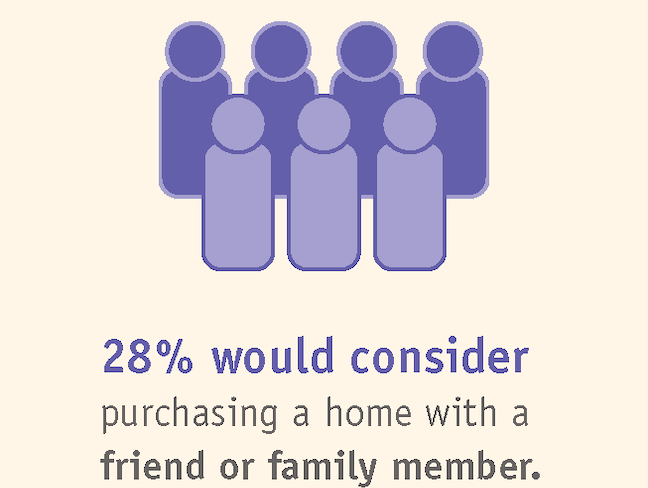
Buyers aren't shying away from asking for help on the path to homeownership. Twenty-eight percent of respondents would consider purchasing a home with a friend or family member and 17% are willing to ask for help from friends and family when purchasing a home.
Data is based on a survey conducted in partnership with Pollfish and fielded October 16, 2023, among 1,000 men and women in the U.S. between the ages 18-54+, who plan to purchase a home in the next 12 months.
